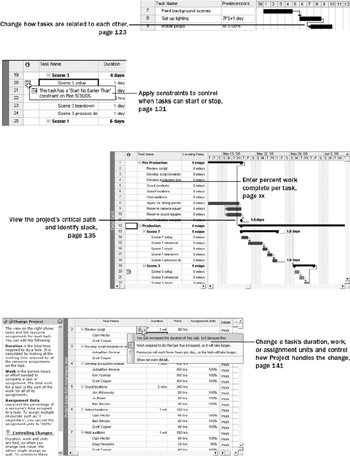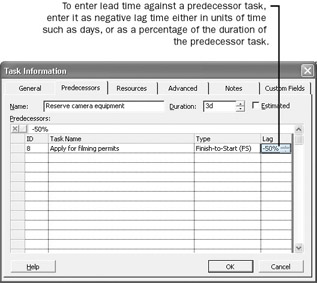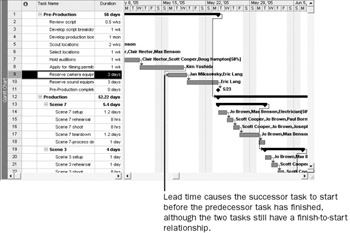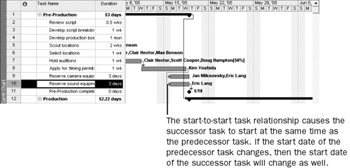Chapter 7: Fine-Tuning Task Details
![]() Download CD Content
Download CD Content

In this chapter you will learn to:
-
Adjust task links to have more control over how tasks are related.
-
Apply a constraint to a task.
-
Identify the tasks on the critical path.
-
Split a task to record an interruption in work.
-
Create a task calendar and apply it to tasks.
-
Change a task type to control how Project schedules tasks.
-
Record deadlines for tasks.
-
Enter a fixed cost and specify how it should accrue.
-
Set up a recurring task in the project schedule.
See Also Do you need a quick refresher on the topics in this chapter? See the quick reference entries on pages xxvi–xxviii.
In this chapter, you examine and use a variety of advanced features of Microsoft Office Project 2003. These features focus on fine-tuning task details prior to saving a baseline and commencing work on the project with the goal of developing the most accurate schedule representation of the tasks you anticipate for the plan.
| Important | On the CD Before you can use the practice files in this chapter, be sure you install them from the book’s companion CD to their default location. See “Using the Book’s CD-ROM,” on page xiii, for more information. |
Adjusting Task Relationships
You might recall from Chapter 2, “Creating a Task List,” that there are four types of task dependencies, or relationships:
-
Finish-to-start (FS): The finish date of the predecessor task determines the start date of the successor task.
-
Start-to-start (SS): The start date of the predecessor task determines the start date of the successor task.
-
Finish-to-finish (FF): The finish date of the predecessor task determines the finish date of the successor task.
-
Start-to-finish (SF): The start date of the predecessor task determines the finish date of the successor task.
When you enter tasks in Project and link them by clicking the Link Tasks button on the Standard toolbar, the tasks are given a finish-to-start (FS) relationship. This might be fine for most tasks, but you will probably want to change some task relationships. Here are some examples of tasks that require relationships other than finish-to-start:
-
You can start setting up the lighting for a film scene as soon as you start setting up the props (start-to-start relationship). This reduces the overall time required to complete the two tasks, as they are completed in parallel:

-
Planning the filming sequence can begin before the script is complete, but it cannot be finished until after the script is complete. You want the two tasks to finish at about the same time (finish-to-finish relationship):

Task relationships should reflect the sequence in which work should be done. After you have established the correct task relationships, you can fine-tune your schedule by entering overlap (called lead time) or delay (called lag time) between the finish or start dates of predecessor and successor tasks.
Assuming that two tasks have a finish-to-start relationship:
-
Lead time causes the successor task to begin before its predecessor task concludes.
-
Lag time causes the successor task to begin some time after its predecessor task concludes.
Here is an illustration of how lead and lag time affect task relationships. Let’s say you initially planned the following three tasks using finish-to-start relationships:

Before task 8 can start, you need to allow an extra day for the paint applied in task 7 to dry. You do not want to add a day to the duration of task 7, because no real work will occur on that day. Instead, you enter a one-day lag between tasks 7 and 8:

However, task 9 can start as soon as task 8 is halfway completed; to make this happen, enter a 50-percent lead time between tasks 8 and 9:

You can enter lead and lag time as units of time (for example, two days) or as a percentage of the duration of the predecessor task (for example, 50 percent). Lag time is entered in positive units, lead time in negative units (for example, minus two days or minus 50 percent). You can apply lead or lag time to any type of task relationship: finish-to-start, start-to-start, and so on.
| Tip | Some of the places you can enter lead or lag time include the Task Information dialog box, and the Predecessors column in the Entry table. |
In this exercise, you change task relationships and enter lead and lag time between predecessor and successor tasks.
| Important | If you are running Project Professional, you may need to make a one-time adjustment to use the My Computer account and to work offline. This helps ensure that the practice files you work with in this chapter don’t affect your Project Server data. For more information, see “Starting Project Professional,” on page 10. |
OPEN: Short Film Project 7a from the \My Documents\Microsoft Press\Project 2003 Step by Step\ Chapter 7 Advanced Tasks folder. You can also access the practice files for this book by clicking Start, All Programs, Microsoft Press, Project 2003 Step by Step, and then selecting the chapter folder of the file you want to open.
-
On the File menu, click Save As.
The Save As dialog box appears.
-
In the File name box, type Short Film Project 7, and then click the Save button.
-
Double-click the name of task 9, Reserve camera equipment.
The Task Information dialog box appears.
-
Click the Predecessors tab.
Here you can see that task 9 has one predecessor task, task 8.
-
In the Lag field for predecessor task 8, type –50%.

Entering lag time as a negative value produces lead time.
-
Click OK to close the Task Information dialog box.
Tip You can also double-click a link line (the lines connecting Gantt bars) on the Gantt chart to enter lead or lag time, change the task relationship, or delete the link.
-
To see how the lag time affects the scheduling of the successor task, on the Standard toolbar, click the Go To Selected Task button.

Project scrolls the Gantt chart to display the Gantt bar for task 9. Task 9 is now scheduled to start when task 8 is 50 percent complete. Should the duration of task 8 change, Project will reschedule the start of task 9 so that it keeps a 50 percent lead time.
Next you will change the task relationship between two tasks.
-
Double-click the name of task 10, Reserve sound equipment.
The Task Information dialog box appears. The Predecessors tab should be visible.
-
Click in the Type column for predecessor task 9. Select Start-to-Start (SS), and click OK.
Project changes the task relationship between tasks 9 and 10 to start-to-start.

| Important | Assigning tasks start-to-start relationships and entering lead times where appropriate are both excellent techniques to shorten overall project duration. However, Project cannot automatically make such schedule adjustments for you. As project manager, you must analyze the sequences and relationships of your tasks and make those adjustments where appropriate. |
EAN: 2147483647
Pages: 199
- Structures, Processes and Relational Mechanisms for IT Governance
- An Emerging Strategy for E-Business IT Governance
- Measuring and Managing E-Business Initiatives Through the Balanced Scorecard
- A View on Knowledge Management: Utilizing a Balanced Scorecard Methodology for Analyzing Knowledge Metrics
- Governing Information Technology Through COBIT